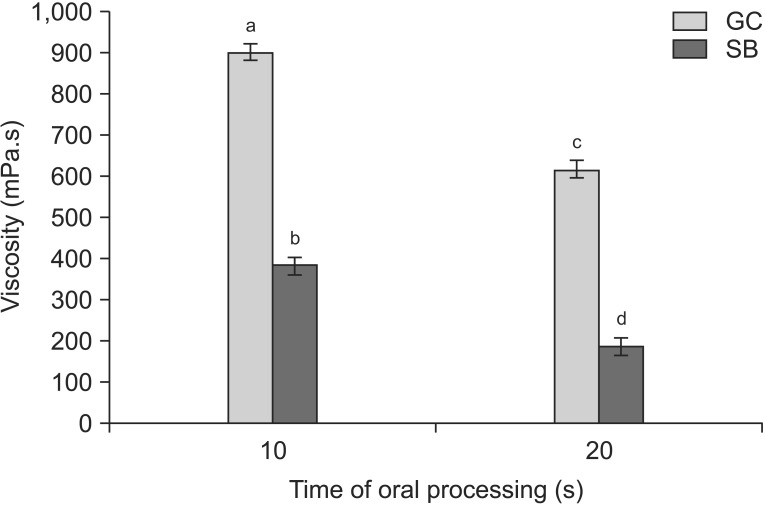Ann Rehabil Med.
2015 Oct;39(5):772-777. 10.5535/arm.2015.39.5.772.
The Effect of Oral Processing on the Viscosity of Thickened Drinks for Patients With Dysphagia
- Affiliations
-
- 1TNO Food and Nutrition, Zeist, The Netherlands. katleen.vallons@tno.nl
- 2AVEBE U.A., Veendam, The Netherlands.
- 3TNO Triskelion B.V., Zeist, The Netherlands.
- KMID: 2148208
- DOI: http://doi.org/10.5535/arm.2015.39.5.772
Abstract
OBJECTIVE
To determine whether a gum-containing thickener maintains its viscosity better during oral processing than a completely starch-based thickener.
METHODS
Thirty-five healthy volunteers participated in a double-blind, cross-over study. Artificial tap water was thickened to honey-like consistency (effective viscosity of 1,300+/-100 mPa.s at a shear rate of 50 per second at 20degrees C) with a starch-based thickener (SB) or a gum-containing thickener (GC). Bolus viscosity was determined after standardized oral processing of the thickened water by the subjects for 10 and 20 seconds. Significant effects were determined by ANOVA analysis and pairwise comparisons.
RESULTS
Both thickeners were susceptible to breakdown during oral processing. However, GC-thickened water retained its viscosity significantly better than SB-thickened water.
CONCLUSION
The presence of gums has a protective effect on the starch hydrolysis by salivary amylase in thickened drinks, which may facilitate safer swallowing.
MeSH Terms
Figure
Reference
-
1. Leslie P, Carding PN, Wilson JA. Investigation and management of chronic dysphagia. BMJ. 2003; 326:433–436. PMID: 12595385.
Article2. Logemann JA. Evaluation and treatment of swallowing disorders. Austin: Pro-Ed;1998.3. Kuhlemeier KV, Palmer JB, Rosenberg D. Effect of liquid bolus consistency and delivery method on aspiration and pharyngeal retention in dysphagia patients. Dysphagia. 2001; 16:119–122. PMID: 11305221.
Article4. Logemann JA, Gensler G, Robbins J, Lindblad AS, Brandt D, Hind JA, et al. A randomized study of three interventions for aspiration of thin liquids in patients with dementia or Parkinson's disease. J Speech Lang Hear Res. 2008; 51:173–183. PMID: 18230864.
Article5. Clave P, Arreola V, Romea M, Medina L, Palomera E, Serra-Prat M. Accuracy of the volume-viscosity swallow test for clinical screening of oropharyngeal dysphagia and aspiration. Clin Nutr. 2008; 27:806–815. PMID: 18789561.6. Cichero JA, Murdoch BE. Dysphagia: foundation, theory and practice. Chichester: John Wiley & Sons;2006.7. Smith A. Dysphagia product update. NHD Dietit Mag. 2013; 88:23–26.8. Hanson B, O'Leary MT, Smith CH. The effect of saliva on the viscosity of thickened drinks. Dysphagia. 2012; 27:10–19. PMID: 21374083.
Article9. Vallons KJ, Helmens HJ, Oudhuis AA. Effect of human saliva on the consistency of thickened drinks for individuals with dysphagia. Int J Lang Commun Disord. 2015; 50:165–175. PMID: 25298105.
Article10. Mandel AL, Peyrot des Gachons C, Plank KL, Alarcon S, Breslin PA. Individual differences in AMY1 gene copy number, salivary α-amylase levels, and the perception of oral starch. PLoS One. 2010; 5:e13352. PMID: 20967220.
Article11. Rohleder N, Nater UM. Determinants of salivary alpha-amylase in humans and methodological considerations. Psychoneuroendocrinology. 2009; 34:469–485. PMID: 19155141.12. National Dysphagia Diet Task Force. National dysphagia diet: standardization for optimal care. Chicago: American Dietetic Association;2002.13. Lai KP, Steffe JF, Ng PK. Average shear rates in the rapid visco analyser (RVA) mixing system. Cereal Chem. 2000; 77:714–716.
Article14. Kim IS, Han TR. Influence of mastication and salivation on swallowing in stroke patients. Arch Phys Med Rehabil. 2005; 86:1986–1990. PMID: 16213243.
Article15. Brennan CS, Blake DE, Ellis PR, Schofield JD. Effects of guar galactomannan on wheat bread microstructure and on the in vitro and in vivo digestibility of starch in bread. J Cereal Sci. 1996; 24:151–160.16. Slaughter SL, Ellis PR, Jackson EC, Butterworth PJ. The effect of guar galactomannan and water availability during hydrothermal processing on the hydrolysis of starch catalysed by pancreatic alpha-amylase. Biochim Biophys Acta. 2002; 1571:55–63. PMID: 12031290.17. Garcia JM, Chambers E 4th, Matta Z, Clark M. Viscosity measurements of nectar- and honey-thick liquids: product, liquid, and time comparisons. Dysphagia. 2005; 20:325–335. PMID: 16633878.
Article
- Full Text Links
- Actions
-
Cited
- CITED
-
- Close
- Share
- Similar articles
-
- Viscosity Control: Effect on Pharyngeal Residue in Dysphagia Patients with Reduced Pharyngeal Constriction
- Standard Recipes for the Preparation of Thickened Barium Liquids Used in the Diagnosis of Dysphagia
- Dietary Modification in Dysphagia
- Principles and Considerations in the Prescription of Dysphagia Diets: Viscosity, Size, Texture, Taste and Temperature
- Considerations and Problems in the Prescription of Dysphagia Diets


